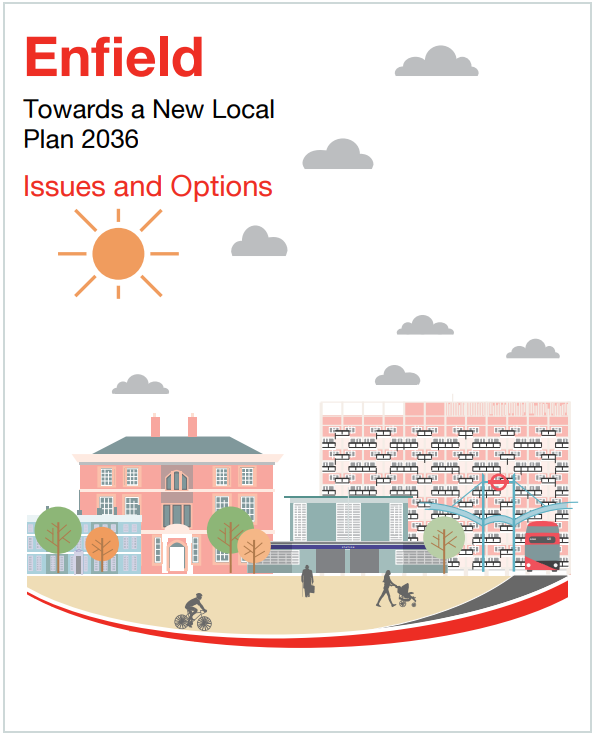In his response to the draft revised Enfield Local Plan, the Mayor of London has voiced concerns about a number of aspects, in particular the proposal to release Green Belt land for construction of new housing. The response also questions the draft plan's wording on tall buildings and emphasizes the need to provide for car-free development and to provide high quality routes and facilities for walkers and cyclists.

Some aspects of the draft Enfield local plan published in November have been questioned by the Mayor of London
The Mayor's response to the document outlining the draft plan - Enfield - Towards a New Local Plan 2036 - comes in a letter from Juliemma McLoughlin, the Greater London Assembly's chief planner, sent to Enfield Council on 28th February, and ending with the sentence "We especially encourage you to talk to us on finding ways to accommodate housing and employment growth without encroaching on the Green Belt." Ms McLoughlin attaches a document containing comments from Transport for London, which she says she endorses.
On the Green Belt issue Ms McLoughlin writes:
"Whilst the Mayor supports the majority of the draft Local Plan’s objectives he does not support the release of the Green Belt as set out in Draft New London Plan Policy G2. The National Planning Policy Framework (NPPF) does not require a review of the Green Belt. The fundamental aim of Green Belt policy is to prevent urban sprawl by keeping land permanently open; the essential characteristics of Green Belts are their openness and their permanence. The retention of the Green Belt is also to assist in urban regeneration by encouraging the recycling of derelict and other urban land. Enfield has two Opportunity Areas, being the Lee Valley and New Southgate. The draft Local Plan identifies numerous potential redevelopment sites in Enfield Town.
"Once established, Green Belt boundaries should only be altered where exceptional circumstances are fully evidenced and justified, through the preparation or updating of plans. The Mayor, in his draft new London Plan, has set out a strategy for London to meet its housing need within its boundaries without encroaching on the Green Belt or the loss of industrial capacity and therefore there are no exceptional circumstances to warrant a Green Belt review."
The letter and attached TfL comments question Enfield Council's assertion that the area around Crews Hill station is a sustainable location for growth, pointing out that the peak service is only three trains an hour (which is actually inaccurate - it was and is two trains per hour) and there is no proper bus service, meaning that "the development of this area would be likely to be car dependent".
The letter also raises doubts about other proposals in the draft, including:
- the council's policy on tall buildings:
"Higher density development does not mean tall buildings. Enfield should note that well designed higher density schemes will bring a range of social and built environment benefits to an area."
- possible release of industrial land for other uses
- allowing town centre uses outside town centres
- housing targets and affordable housing
- reducing the impact of private vehicles:
"The positive approach to car-lite housing should be expanded to encourage car-free development in line with the draft London Plan".
Points made in the more detailed TfL comments include:
- Major transport projects:
"It should be noted that the East-West Rapid Transit strategic and major road enhancement projects within Enfield, are not included as specific projects in the draft London Plan or Mayor’s Transport Strategy and would require further assessment as there is no current commitment or funding secured."
- Active travel:
"TfL welcomes the emphasis in this policy and elsewhere in making active travel the natural choice, consistent with the Mayor’s approach in the draft London Plan and the Mayor’s Transport Strategy. Reference should be made to the requirement to meet London Plan policy T5 cycle parking standards as a minimum and for the need to have regard to design guidance including the London Cycling Design Standards (LCDS) or any successor document. The Healthy Streets approach referred to in Local Plan policy T2 will also have a role to play here. In relation to part c care should be taken to ensure that any routes to be used by both cyclists and walkers are fit for purpose and designed to appropriate standards as set out in LCDS."
- Crossrail 2:
Correcting the draft plan's assertion that Crossrail 2 is contingent on building 40,000 homes: "This should be reworded to reflect that the Crossrail 2 Business Case indicates that the scheme could unlock around 20 to 30,000 extra homes in Enfield, and that the delivery of this many new homes is not a requirement for the scheme to happen – it is the scale of new housing that the scheme could unlock."
- Tunnelling the North Circular Road:
"[T]he plan should make it clear that road tunnelling at New Southgate remain[s] unfunded."
Links
Re: Consultation on Enfield Towards a New Local Plan 2036 – Issues and Options (Letter to Enfield Council from GLA chief planner, February 2019)
Enfield: Towards a new Local Plan 2036 (Draft plan published November 2018)



